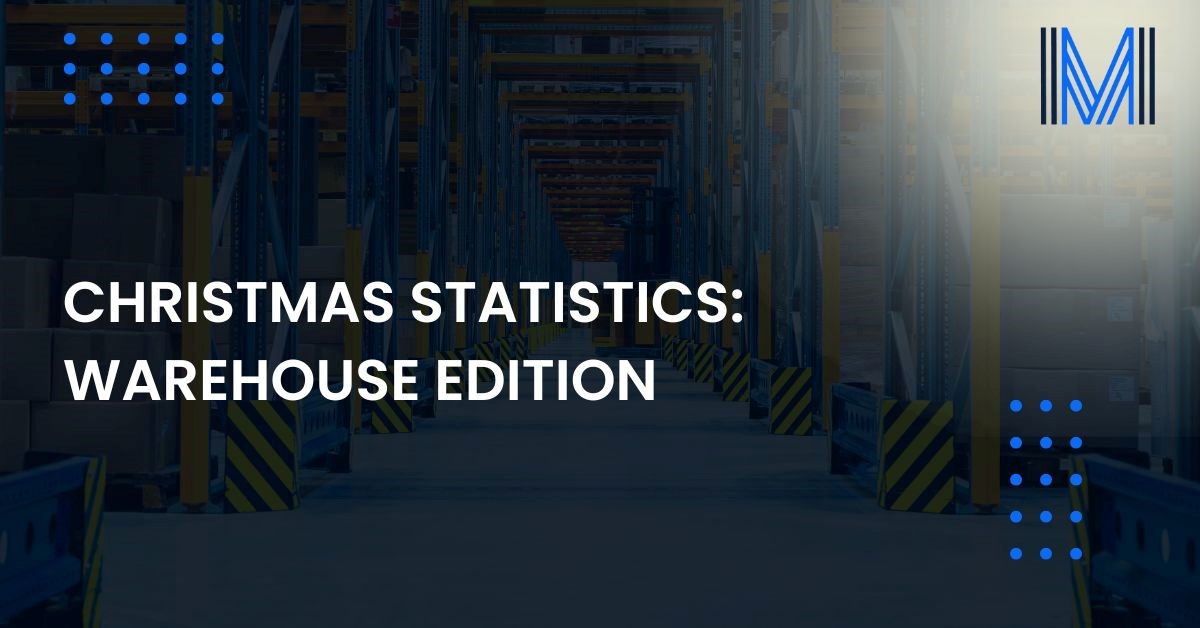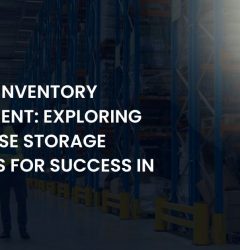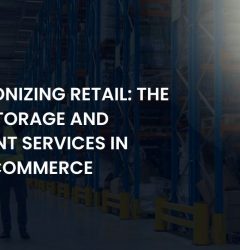06 May

Christmas is just around the corner, and warehouses are ramping up their efforts to get presents out on time. The holiday season is one of the busiest seasons for any logistics company, and any delay or disruption could have a lasting negative impact on the business.
Creating a solid warehouse management strategy is the best way to manage such a busy time. With the right approach, you can optimise picking and packing and create a smooth supply chain. Here’s a look at some warehouse Christmas statistics to help you create a great logistics strategy.
What Is Peak Season Shopping?

Peak seasons fall during holidays such as Black Friday, Cyber Monday and Christmas, as many customers want to purchase gifts, buy new goods for themselves or take advantage of great sales incentives. Most consumers also do their Christmas earlier during Black Friday and Cyber Monday to take advantage of good deals.
Some eCommerce companies also experience a sales peak during Mother’s Day, Father’s Day, Valentine’s Day, and other regional holidays. However, most sales often occur during the holiday season, as these days are notorious for discounted prices and major sales initiatives.
In peak season, order and shipment volumes increase significantly, leading to higher fulfilment rates and a busier returns process. In addition, supply chains experience a drop in efficiency due to disruptions. This can make it difficult for eCommerce brands to keep up with sales demands, manage their inventory and fulfil high volumes of orders.
Ecommerce Statistics for Warehouses
Nowadays, eCommerce is the preferred way for many consumers to shop, and the Christmas season is no different.
In many countries, the holiday season signals record-breaking sales and consumer spending. With that in mind, you must consider Christmas eCommerce and marketing statistics before creating your strategy. This will give you an estimate as to how busy warehouses will become during Christmas and how to cope with high order volumes.
Christmas Retail Sales Set To Exceed £94 Billion in 2023
In the past ten years, Christmas retail sales have been steadily rising worldwide. In the UK, there’s been a significant jump in Christmas sales figures between 2018 and 2013. In 2018, UK holiday season sales reached £79.8 billion. This figure is set to increase by an estimated £15 billion, reaching a forecasted total of £94 billion.
With these rises, we can see that more people are partaking in seasonal sales and special deals. This figure also gives warehouses and logistics an idea of how to prepare for the upcoming.
To stay on top of orders, it’s crucial to manage your staff adequately and ensure a smooth-flowing supply chain. Your delivery couriers should also optimise their routes to reach consumers on time and avoid unhappy customers during the holiday season.
Overall Christmas Retail Sales Expected To Reach High Figures in 2023
In 2023, worldwide Christmas retail sales are expected to increase by 4.5% from previous years, reaching $1.3 trillion, with eCommerce making up nearly 20% of sales. This was a 48.5% increase from last year’s eCommerce spending.
Nowadays, warehouses and fulfilment centres are crucial to maintain eCommerce order processing. With so many customers choosing digital shopping over in-person retail, warehouses should maintain efficient operations to minimise errors. udadfjhcvg\’
Christmas Shopping Is Starting Early and Ending Late This Year
In previous years, most consumers did their holiday shopping a few weeks before Christmas; however, these trends have changed recently, with many people starting their shopping as early as November. Nearly 40% of US consumers began Christmas shopping in November, up from 35% last year.
About 50% of US consumers started purchasing even earlier from October. These figures show that people are more likely to buy goods earlier, so warehouses must prepare well before autumn to maintain efficient order processing.
What Products Are Consumers Gifting This Christmas?

While gifts remain the most common purchase during Christmas, we must also consider sales of other items, such as decorations, Christmas trees and more.
Since warehouses handle a wide range of products, looking at the trends and patterns of various goods can help you create an all-round management strategy. Here are some Christmas shopping statistics to help you understand consumer behaviour by product.
Parcel Deliveries On The Rise
The Christmas season is always the busiest time for most warehouses as they need to ramp up their services and get parcels out on time. In 2022, 15 million parcels were delivered in the UK alone, showing a 9% increase from last year.
On a bigger scale, 159 billion parcels were delivered worldwide, with 436 million delivered daily. With these figures, logistic facilities can estimate how busy they will get during Christmas and adjust accordingly.
Gift Cards And Clothing Popular Gift Items In The US
According to various market surveys, consumers in the US are more likely to purchase apparel items and gift cards as Christmas gifts than any other product. Apparel warehouses are often busy throughout the year but may experience a surge of orders during the holiday season.
Since these warehouses deal with a high volume of SKUs, it’s crucial to maintain organisation in your storage. An innovative and tech-based warehouse management system will help you stay afloat during the busy Christmas shopping season.
Apparel sectors are also notorious for returns, especially during the holiday season. Make sure to provide quality support and management to create a smooth returns process for customers.
Beauty and Personal Care Items Popular Gifting Options in the UK
Apart from gift cards, vouchers and monetary presents, consumers in the UK wished to receive beauty, cosmetics and personal care items for Christmas. Apparel ranked fourth on this Christmas wishlist, which was conducted as a market survey.
If your warehouse deals with cosmetic and beauty items, you must create an efficient strategy to keep up with this demand during the peak season. Such products require careful handling to avoid breakages during delivery.
You also need to conduct batch organisation to avoid mixing expiration dates. Consider these factors
Fluctuations In Global Christmas Decoration Sales
Christmas decorations are an integral part of the holiday season, which means there will be high demand for sales of such goods during peak shopping seasons.
In 2021, the global Christmas decoration market is estimated to be worth $6.8 billion. This figure is expected to rise to $9 billion by 2026. Even with the rising market size, people are buying fewer decorations in the face of inflation.
Consumers are prioritising gifts over decorative items to reduce expenditure during the Christmas season. A warehouse should be equipped to handle order fluctuation during this time due to changing demand for items.
Shopping Habits To Look Out For
Warehouses must keep up with shopping trends and consumer behaviours to prepare their supply chain strategy for the Christmas season. Every year, consumers’ patterns and buying trends are influenced by several factors that could either increase or decrease the Christmas volume order.
The best way to maintain supply chain agility is by taking note of these changes and adjusting accordingly. Let’s look at the statistics highlighting recent shopping behaviours.
Inflation A Major Concern For Christmas Shoppers
Recent economic crises and inflation have affected consumers worldwide, and this Christmas season, many are becoming more conscious of what they purchase. Over 88% of consumers believe inflation will impact their spending this year.
While inflation can make buyers more conscious of their spending, it doesn’t necessarily mean that supply chains will be light this season. Warehouses must maintain flexibility and agility to keep up with fluctuating demand during this year’s Christmas season.
Mobile Sales Soar High
Most consumers are on the go, and mobile shopping has made it more convenient for consumers to get the products they want. In 2022, Shopify experienced a record-breaking $7.5 billion during the holiday season.
A significant portion of these sales were made through the mobile app. Warehouses that operate as 3PLs for eCommerce should use this opportunity to create a clear and direct communication channel for a smooth Christmas season.
Make sure that all stock information on websites and apps directly reflects the inventory in your warehouse to avoid dissatisfied customers.
What Are The Common Challenges During Christmas Season?

Peak shopping season can cause major disruptions for shipping warehouses—problems such as these strain the relationship between eCommerce and fulfilment centres.
To create your peak season strategy, you must identify the challenges and find ways to overcome them. Here are some common concerns during the busy sales season.
Order Volume
One of the biggest issues during peak season shipping is the volume of orders. Due to significant sales, customers are more likely to make more purchases during this period.
With online shopping making it easier to place orders, eCommerce companies should expect a high order volume. Often, these orders can build up and become overwhelming to ship out.
Preparation is key if you want to avoid volume issues. Optimising your shipments and prioritising supply chain resilience are excellent ways of combatting volume issues and sending out orders as soon as possible.
A quality 3PL service will help you keep track of your inventory and provide accurate logistics that help you map out deliveries. These features are crucial to stay on top of high-volume orders.
Season-Specific Sales
As we’ve mentioned, high volume is one of the major disruptions during a peak season. However, season-specific sales can worsen this issue as consumers are willing to purchase more during this period. This is why eCommerce stores must implement proper techniques to manage busy seasons.
Peak season can become extremely chaotic and overwhelming for online businesses without proper management, leading to devastating sales consequences.
Speed of Delivery
Order fulfilment and shipment speed matters more than ever during the peak season. If your business relies on other manufacturers or uses dropshipping, know these services will increase demand during peak season.
Without an optimised schedule, you could experience severe delays or shortages. Make sure to discuss with your services beforehand how your deliveries will be handled to minimise disruptions.
Order Accuracy
Speed and order accuracy go hand in hand because consumers want you to get their order exactly right, especially during the peak holiday season when getting returns is hard. This means your order fulfilment should maintain accuracy to avoid dissatisfied customers.
You may need to go beyond manual fulfilment to maintain speed and accuracy. Investing in 3PL services will help you keep things organised and get the order out on time.
Unreliable 3PLs
If you partner with a 3PL, ensure they have the technology, experience and expertise to handle peak shipping season. Choosing the wrong 3PL service can cause disorganisation in your order fulfilment process. This can lead to inaccurate order processing, missed shipments, slower deliveries and inaccurate inventory checks.
A good 3PL partner should always provide visibility and transparency into all supply chain management features, including storage details, real-time inventory information, fulfilment and delivery performance and much more.
If unsatisfied with your current 3PL service, consider switching as soon as possible to prepare for the upcoming year’s peak season. Choosing technology-based 3PL, like Meteor Space, can help you get orders out quickly and ensure smooth sailing in busy seasons.
Choose Meteor Space As Your Logistic Partner This Christmas
If you want a quality 3PL service that provides excellent order fulfilment services with innovative tech-based tools, choose Meteor Space. We offer many features to help online stores through all packaging and shipping needs.
Meteor’s expert team members use their knowledge to get you through peak sales seasons without losing efficiency. Our technology-based services provide excellent management and organisation programs to help you stay on top of your inventory.
You can also access Meteor’s easy-to-use web portal, fast shipping, efficient pick and pack and much more.


